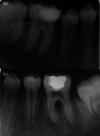Follow-up of patients subjected to direct and indirect pulp capping of young permanent teeth. A retrospective study
- PMID: 33382210
- PMCID: PMC8404490
- DOI: 10.1002/cre2.362
Follow-up of patients subjected to direct and indirect pulp capping of young permanent teeth. A retrospective study
Abstract
Objective: A retrospective study of the success rate of direct pulp capping (DPC) and indirect pulp capping (IPC) was carried out in children between 6-14 years-old, considering separately primary caries or caries affecting teeth with molar incisor hypomineralization (MIH).
Material and methods: Data were collected in a dental public health service. Following the inclusion criteria, 232 treatments were analyzed. Success was defined by the presence of a functional tooth without clinical signs or symptoms of pulpal or periapical disease. The success rate was correlated to patient gender, the affected tooth and the indication of therapy using the chi-squared and Fisher exact test. The success time related to treatment type was evaluated through the Mann-Whitney test.
Results: The IPC and DPC success rate was 99.4%, and 84.6%, respectively (p = .01). Success was significantly lower when caries affected teeth with MIH than when caries affected teeth without MIH (p = .01). The mean survival for DPC and IPC was 14.07 ± 1.30 and 15.98 ± 0.80 months, respectively (p = .07).
Conclusions: When caries were located in teeth that were not affected by MIH, IPC was significantly more successful than DPC, but did not differ significantly when caries were placed in teeth with MIH. Key points Minimally invasive therapy is a successful approach for decayed young permanent teeth. The success of IPC was greater than the success of DPC wen caries was placed in teeth not affected by MIH. In teeth not affected by MIH the success of DPC or IPC did not differ significantly.
Keywords: Vital pulp therapy; direct pulp capping; indirect pulp capping; young permanent teeth.
© 2020 The Authors. Clinical and Experimental Dental Research published by John Wiley & Sons Ltd.
Conflict of interest statement
The authors declare that they have no conflict of interest.
Figures



Similar articles
-
Outcomes of Direct Pulp Capping by Using Either ProRoot Mineral Trioxide Aggregate or Biodentine in Permanent Teeth with Carious Pulp Exposure in 6- to 18-Year-Old Patients: A Randomized Controlled Trial.J Endod. 2018 Mar;44(3):341-348. doi: 10.1016/j.joen.2017.10.012. Epub 2017 Dec 21. J Endod. 2018. PMID: 29275850 Clinical Trial.
-
Comparative Analysis of Biodentine, Calcium Hydroxide, and 2% Chlorhexidine with Resin-modified Glass Ionomer Cement as Indirect Pulp Capping Materials in Young Permanent Molars.J Contemp Dent Pract. 2021 May 1;22(5):511-516. J Contemp Dent Pract. 2021. PMID: 34318769
-
Prognostic factors in direct pulp capping with mineral trioxide aggregate or calcium hydroxide: 2- to 6-year follow-up.Clin Oral Investig. 2017 Jan;21(1):357-367. doi: 10.1007/s00784-016-1798-z. Epub 2016 Apr 4. Clin Oral Investig. 2017. PMID: 27041110
-
Contemporary management of deep caries in primary teeth: a systematic review and meta-analysis.Eur Arch Paediatr Dent. 2022 Oct;23(5):695-725. doi: 10.1007/s40368-021-00666-7. Epub 2022 Jan 4. Eur Arch Paediatr Dent. 2022. PMID: 34981447
-
Biodentine or Mineral Trioxide Aggregate as Direct Pulp Capping Material in Mature Permanent Teeth with Carious Exposure? A Systematic Review and Meta-analysis.Oper Dent. 2021 Nov 1;46(6):631-640. doi: 10.2341/20-277-LIT. Oper Dent. 2021. PMID: 35507905
Cited by
-
Antimicrobial photodynamic therapy and deproteinization in teeth with molar incisor hypomineralization: a case series.Transl Pediatr. 2025 Feb 28;14(2):311-321. doi: 10.21037/tp-24-480. Epub 2025 Feb 25. Transl Pediatr. 2025. PMID: 40115448 Free PMC article.
References
-
- Agrafoti, A., Ginnakoulas, D. G., Filippatos, C. G., & Kontakiotis, E. G. (2005). Analysis of clinical studies related to apexification techniques. European Journal of Paediatric Dentistry, 21, 1–8. - PubMed
-
- Alqaderi, H. E., Al‐Mutawa, S. A., & Qudeimat, M. A. (2014). MTA pulpotomy as an alternative to root canal treatment in children's permanent teeth in a dental public health setting. Journal of Dentistry, 42, 1390–1395. - PubMed
-
- American Academy of Pediatric Dentistry ad hoc Committee on Pedodontic Guideline on Prescribing Dental Radiographs for Infants, Children . (2012). Adolescents, and persons with special health care needs. Pediatric Dentistry, 34, 189–191. - PubMed
-
- American Academy on Pediatric Dentistry Clinical Affairs Committee‐Pulp Therapy Subcommittee, American Academy on Pediatric Dentistry Council on Clinical Affairs . (2008). Guideline on pulp therapy for primary and young permanent teeth. Pediatric Dentistry, 30, 170–174. - PubMed
-
- Asgary, S., Eghbal, M. J., Ghoddusi, J., & Yazdani, S. (2013). One‐year results of vital pulp therapy in permanent molars with irreversible pulpitis: An ongoing multicenter, randomized, non‐inferiority clinical trial. Clinical Oral Investigations, 17, 431–439. - PubMed
MeSH terms
Substances
LinkOut - more resources
Full Text Sources

